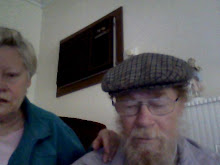Being fascinated by tessellations, of which I have managed to create quite a few (which you may view on my website http://www.ozzigami.com.au/, go to my tessellations and punography page) I went looking in my local library for references to MC Escher, who started it all. ( 'it' in this case meaning specifically lifelike tessellations since the word really just means 'tilings' which have been around longer than the Wheel!) There I found just 2 references, one is a big book of Escher's designs, "ESCHER The Complete Graphic Work" which oddly is not true to label, at least 2 of his tessellations, Sea-Horses and one of greyhound-like Dogs are missing! Anyway the other book is Jane Langton's "The Escher Twist". I have borrowed both books. Her title interested me strangely: a decade ago I wrote "A Yarn with an Escheresque Twist", an anecdotal account of a series of concatenating events which formed a sort of Moebius strip in my life. I'm going to put this on my blog, both this letter to you and my story, it's sort of interesting, (at least to me). As for Ms Langton's book, it's certainly a bit turgid and not necessarily very believable, and it ends up a lot neater than most things in life and death . . . but then . . . it is called "The Escher Twist", Escher's work is all of the above, (and in Spades, as they say) so that's fair eh!
Anyway, here's my 1996 story,
"A Yarn with an Escheresque Twist" :
Having developed some special nets for making the 5 Platonic Solids, I rang the SA Curriculum Centre to see if I could gee some interest at schools. I found myself talking to Will Morony, AAMT President. He was mildly interested in our nets, but told me he was planning to go to ICME 8, The International Convention of Mathematics Teachers, in Seville, Spain, in a few weeks, and that he wanted to find a tessellation to distribute there as a sort of Australian visiting card. I was astonished: I had mentioned nothing about tessellations, and I had no idea that mathematicians were even interested in them. Anyway I wasted no time in telling him about OZZIE the Magic Kangaroo; when he saw the design he said instantly that he would like to use it. I worked up a variation to fit on a peel-&-stick icosahedron (pretty!) and while in the throes of having it printed I visited the AAMT office. There I noticed the cover of AMT Vol 51 no 4 1995 edition, featuring a locally-made chessboard with a very clever surface design, an Escher-like lizard breaking through the squares. I contacted its creator, Mark Shearer of Glyph Fine Marquetry; within days he had produced a stunning OZZIE-tessellation chessboard, which attracted many compliments when displayed in Spain.
A few weeks later I received a phone call from Dr. Paul Scott, Associate Professor of Pure Mathematics at Adelaide University, and longtime Executive Editor of Australian Mathematics Teacher, (rated by many as the finest Mathematics Teachers journal in the Universe.) It transpired that Mark Shearer had mentioned OZZIE tessellation to Paul, who graciously invited me to write an AMT article. [ Me! - a Maths article !!! ]
When I went to meet Dr Scott at his office, I was delighted to spy his splendid collection of geometrical models: beautiful coloured stellations, some of which must have taken many many hours to make. Naturally I presented him with a set of our unique dazzling peel-&-stick polyhedral nets. Within a couple of days he rang me to tell me he had constructed the solids, and that they now occupied pride of place in the very centre of his collection! And best of all, he offered to review them in AMT.
OZZIE gloried in full colour as the centrefold in Vol 52 No 4 1996 issue of AMT. Two pages further on was Paul's glowing review of our Plato's Jewels. I will quote just these two key comments: ". . . brilliant! . . . Highly recommended!" (emphasis Dr Scott's)
Where does the Escherness come in . . ? . . Remember, I rang Will, intending to talk about Platonic Solids, but instead OZZIE Tessellation took centre stage. Then Paul rang me to talk about OZZIE, and our common interest in polyhedra took over, closing a kind of Moebius loop of events. Nice!
Friday, January 23, 2009
Subscribe to:
Post Comments (Atom)



1 comment:
Post a Comment